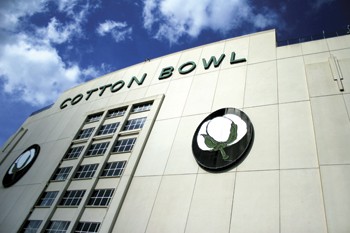
(Nick McCarthy)
There are no people in the Cotton Bowl on this weekday, but there are no seats either. The white and blue seats are gone, ripped out over the past few months. Soon there will be new bleacher seating throughout, but for now, the stadium is in transition.
And not just in a physical way.
On Feb. 27, the Cotton Bowl Committee announced that the venue’s signature event, the AT&T Cotton Bowl Classic, would move west to the new Dallas Cowboys stadium beginning in 2010.
The move is designed to upgrade the bowl game from second-tier status to possible Bowl Championship Series level but it also puts the Fair Park stadium in jeopardy.
“It will lose all of its history after they move,” said SMU senior Ryan Wolcott, grandson of SMU great Doak Walker.
The Walker family has strong ties to the Cotton Bowl. It is because of Doak that the current structure exists. Doak and the Mustangs were undefeated going into a game against the University of Texas in late 1947, and ticket requests were so numerous that the game was moved from Ownby Stadium on campus to the Cotton Bowl.
The Cotton Bowl held 47,000 people at the time, and there were still not enough tickets to meet the demand. University and city officials agreed to enlarge the Cotton Bowl so more fans could attend games. SMU permanently moved to the Cotton Bowl beginning in 1948, and by the 1949 season the stadium was topped out with a capacity of 75,000. The stadium earned the nickname, “The House that Doak Built.” Walker himself won the Heisman Trophy in 1948, the only player in SMU history to do so.
Kris Wolcott, mother of Ryan and daughter of Doak, said the bowl game and the stadium mean a lot to their family.
“It made me really sad because it’s been there so many years,” Kris Wolcott said about the bowl game’s move to Arlington.
One of the reasons the Cotton Bowl means so much, said Kris Wolcott, is that one of the final things that happened before Doak’s death in 1998 was his induction into the Cotton Bowl Hall of Fame. At the next year’s Cotton Bowl, Texas running back Ricky Williams honored Doak by wearing his uniform number, 37, instead of his normal 34.
Kris Wolcott said she has lost count of how many times she has been to the Cotton Bowl and added that it is something she looks forward to every year. She, like those responsible for the maintainence of the stadium, is unsure of its future once the New Year’s Day game leaves. She thinks that high-school games or other uses could keep the stadium relevant.
“I just hope it won’t be knocked down,” she said.
The stadium is in the middle of $50 million worth of renovations courtesy of a Dallas bond election in 2005.
But there is a debate on whether the renovations are worth it. City boosters say the stadium can still be upgraded enough so they can keep the annual Texas-Oklahoma football game. At a press conference held the day the bowl game left for Arlington, Dallas Citizens Council chairman Tom Dunning told the media that the stadium is still good enough for college football.
“Eighty degrees outside, the perfect weather for college football,” he said, a reference to the fact the bowl game left due to unpredictable January weather.
Bowl officials said they needed an enclosed stadium to attain BCS status. Right now the bowl is not a part of the rotation that involves hosting the national championship game.
The Texas-OU series is also in doubt, as the City of Dallas only has a commitment from the two schools through 2010. After that they are free to renew their contract with the city or go elsewhere. The schools have considered making the game a home and home series or moving to Arlington.
Upgrades to the Cotton Bowl already completed include a brand new scoreboard and videoboard and additional seating in the end-zones that have increased capacity by 5,000.
Work still to be done includes more seating that would push capacity to 90,000, installation of the bleacher seats, widening of the concourses and upgrades to the bathrooms and concessions areas.
Ryan, who has been to nearly 20 games at the Cotton Bowl and attended the 2006 Texas-OU game, said that it’s obvious the facility needs a face lift but that he believes the atmosphere there is something special.
“It can still be a place where teams want to play,” he said.









